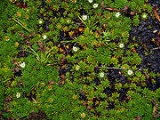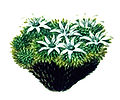
Donatia
Encyclopedia
Donatia is a genus of two cushion plant
species in the monogeneric family Donatiaceae. In the past, Donatia has been placed in the subfamily Donatioideae, described by Johannes Mildbraed
in his 1908 taxonomic monograph of the family Stylidiaceae
. The subfamily was created to distinguish the difference between the single genus
Donatia from the five typical genera
of the Stylidiaceae that Mildbraed placed in the Stylidioideae subfamily. The subfamily taxonomy represented the taxonomic uncertainty of Donatia, which had at one point also been placed in the Saxifragaceae
. Donatia differs sufficiently from the genera in the Stylidiaceae in that it has free stamen
s and petals, paracytic stomata, and a pollen morphology distinct from the other genera. Because of this and the recent phylogenetic analysis based on rbcL genes, more recent treatments have segregated Donatia into its own family, the Donatiaceae. The molecular phylogenetic analysis has placed Donatia as a sister-group to Stylidiaceae, thus leaving the Stylidiaceae as a monophyletic family.
 As early as 3 years after Mildbraed's publication of the subfamily Donatioideae, other authors began to question the placement and argued for recognition of Donatiaceae. In 1915, Carl Skottsberg
As early as 3 years after Mildbraed's publication of the subfamily Donatioideae, other authors began to question the placement and argued for recognition of Donatiaceae. In 1915, Carl Skottsberg
formally published the Donatiaceae. The APG II system recommends the inclusion of Donatia in Stylidiaceae but allows for the optional recognition of the family Donatiaceae. The two species in the genus represent a wide geographic range. D. novae-zelandiae is found in the alpine
and subalpine
regions of New Zealand
and Tasmania
while D. fascicularis is native to similar habitats in southern South America
to latitude 40°S
.
Cushion plant
A cushion plant is a compact, low growing, mat forming plant that is found in alpine, subalpine, arctic, or subarctic environments around the world...
species in the monogeneric family Donatiaceae. In the past, Donatia has been placed in the subfamily Donatioideae, described by Johannes Mildbraed
Johannes Mildbraed
Gottfried Wilhelm Johannes Mildbraed was a German botanist that specialized in mosses, ferns, and various spermatophytes. He is well-known for authoring the most current monograph and taxonomic treatment of the family Stylidiaceae in 1908 as part of the unfinished Das Pflanzenreich series. The...
in his 1908 taxonomic monograph of the family Stylidiaceae
Stylidiaceae
The family Stylidiaceae is a taxon of dicotyledonous flowering plants. It consists of five genera with over 240 species, most of which are endemic to Australia and New Zealand. Members of Stylidiaceae are typically grass-like herbs or small shrubs and can be perennials or annuals...
. The subfamily was created to distinguish the difference between the single genus
Genus
In biology, a genus is a low-level taxonomic rank used in the biological classification of living and fossil organisms, which is an example of definition by genus and differentia...
Donatia from the five typical genera
Genus
In biology, a genus is a low-level taxonomic rank used in the biological classification of living and fossil organisms, which is an example of definition by genus and differentia...
of the Stylidiaceae that Mildbraed placed in the Stylidioideae subfamily. The subfamily taxonomy represented the taxonomic uncertainty of Donatia, which had at one point also been placed in the Saxifragaceae
Saxifragaceae
Saxifragaceae is a plant family with about 460 known species in 36 genera. In Europe there are 12 genera.The flowers are hermaphroditic and actinomorphic...
. Donatia differs sufficiently from the genera in the Stylidiaceae in that it has free stamen
Stamen
The stamen is the pollen producing reproductive organ of a flower...
s and petals, paracytic stomata, and a pollen morphology distinct from the other genera. Because of this and the recent phylogenetic analysis based on rbcL genes, more recent treatments have segregated Donatia into its own family, the Donatiaceae. The molecular phylogenetic analysis has placed Donatia as a sister-group to Stylidiaceae, thus leaving the Stylidiaceae as a monophyletic family.

Carl Skottsberg
Carl Johan Fredrik Skottsberg was a Swedish botanist and explorer of Antarctica.Skottsberg was born in Karlshamn, began his academic studies at Uppsala University in 1898 and received his doctorate and a docentship there in 1907...
formally published the Donatiaceae. The APG II system recommends the inclusion of Donatia in Stylidiaceae but allows for the optional recognition of the family Donatiaceae. The two species in the genus represent a wide geographic range. D. novae-zelandiae is found in the alpine
Alpine climate
Alpine climate is the average weather for a region above the tree line. This climate is also referred to as mountain climate or highland climate....
and subalpine
Subalpine
The subalpine zone is the biotic zone immediately below tree line around the world. Species that occur in this zone depend on the location of the zone on the Earth, for example, Snow Gum in Australia, or Subalpine Larch, Mountain Hemlock and Subalpine Fir in western North America.Trees in the...
regions of New Zealand
New Zealand
New Zealand is an island country in the south-western Pacific Ocean comprising two main landmasses and numerous smaller islands. The country is situated some east of Australia across the Tasman Sea, and roughly south of the Pacific island nations of New Caledonia, Fiji, and Tonga...
and Tasmania
Tasmania
Tasmania is an Australian island and state. It is south of the continent, separated by Bass Strait. The state includes the island of Tasmania—the 26th largest island in the world—and the surrounding islands. The state has a population of 507,626 , of whom almost half reside in the greater Hobart...
while D. fascicularis is native to similar habitats in southern South America
South America
South America is a continent situated in the Western Hemisphere, mostly in the Southern Hemisphere, with a relatively small portion in the Northern Hemisphere. The continent is also considered a subcontinent of the Americas. It is bordered on the west by the Pacific Ocean and on the north and east...
to latitude 40°S
40th parallel south
The 40th parallel south is a circle of latitude that is 40 degrees south of the Earth's equatorial plane. It crosses the Atlantic Ocean, the Indian Ocean, Australasia, the Pacific Ocean and South America....
.

